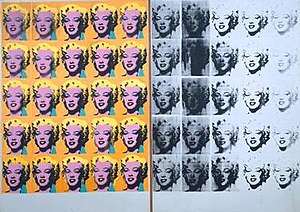Marilyn Diptych
The Marilyn Diptych (1962) is a silkscreen painting by American pop artist Andy Warhol depicting Marilyn Monroe. The piece is one of the artist's most noted works. It is in the collection of the Tate.[2]
| Marilyn Diptych | |
|---|---|
 | |
| Artist | Andy Warhol |
| Year | 1962 |
| Medium | Acrylic paint on canvas[1] |
| Dimensions | 205.44 cm × 289.56 cm (80.88 in × 114.00 in) |
| Location | Tate |
History
Silk-screening was the technique used to create this painting. The twenty-five images on the left are painted in color, the right side is black and white. The painting consists of 50 images.[3]
The work was completed during the weeks after Marilyn Monroe's death in August 1962. The fifty images of the actress are all based on a single publicity photograph from the film Niagara (1953).
Analysis
It has been suggested that the relation between the left side of the canvas and the right side of the canvas is evocative of the relation between the celebrity's life and death.[1][4][5] The work has received praise from writers such as American academic and cultural critic Camille Paglia, who wrote in 2012's Glittering Images lauding how it shows the "multiplicity of meanings" in Monroe's life and legacy.[6]
In a December 2, 2004 article in The Guardian, the painting was named the third most influential piece of modern art in a survey of 500 artists, critics, and others.[7] The artwork was also ranked ninth in the past 1000 years by Kathleen Davenport, Director, Rice University Art Gallery, Houston.[8]
The artwork was bought by art / design show organizer / collector Emily Hall Tremaine out of Warhol's studio in 1962, among several other noted early works by Warhol. This work was sold to the Tate Gallery in 1980. Over the years, Marilyn Diptych has been in numerous exhibitions, including Witty, Sexy, Gimmicky: Pop 1957-67 at Tate Modern, April 27, 2015 - January 10, 2016.[9]
References
- "Andy Warhol Marilyn Diptych 1962". Tate. February 2016. Retrieved 2018-10-14.
- Andy Warhol; Marilyn Diptych 1962. Tate Museum web page
- "Marilyn Diptych".
- Helen Gardner, et al. Gardner's Art Through the Ages. Thompson Wadsworth, 2004. 1054.
- Carol Salus. "Behind the Celestial Enchantment". The Poetry of Life in Literature. Ed. Anna-Teresa Tymieniecka. Springer, 2000. 198.
- Rosen, Gary (October 16, 2014). "The Pagan Aesthetic". The Wall Street Journal. Retrieved July 17, 2014.
- Charlotte Higgins. "Work of art that inspired a movement ... a urinal". The Guardian. December 2, 2004. Retrieved October 22, 2019.
- (May 19, 2000). Which art will top the Chartres? Four curators share their Top 10 picks and reasoning behind the most influential visual artworks of the past 1,000 years. Christian Science Monitor, p. 12. Retrieved October 22, 2019.
- Andy Warhol. Marilyn Monroe diptych, (1962). (March 15, 2019). artdesigncafe.com. Retrieved October 22, 2019.